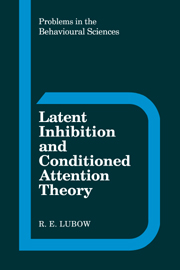Book contents
- Frontmatter
- Contents
- Preface
- 1 Introduction
- 2 Latent inhibition testing procedures
- 3 Variables affecting latent inhibition
- 4 Organismic variables affecting latent inhibition
- 5 Associative learning tests of the effects of stimulus preexposure in children and adults
- 6 Neural substrates of latent inhibition
- 7 Theories and explanations of latent inhibition in animals
- 8 Conditioned attention theory of latent inhibition
- 9 Conditioned attention theory as applied to latent inhibition in humans
- 10 Some applications of conditioned attention theory: learned helplessness and schizophrenia
- Notes
- References
- Author index
- Subject index
7 - Theories and explanations of latent inhibition in animals
Published online by Cambridge University Press: 13 October 2009
- Frontmatter
- Contents
- Preface
- 1 Introduction
- 2 Latent inhibition testing procedures
- 3 Variables affecting latent inhibition
- 4 Organismic variables affecting latent inhibition
- 5 Associative learning tests of the effects of stimulus preexposure in children and adults
- 6 Neural substrates of latent inhibition
- 7 Theories and explanations of latent inhibition in animals
- 8 Conditioned attention theory of latent inhibition
- 9 Conditioned attention theory as applied to latent inhibition in humans
- 10 Some applications of conditioned attention theory: learned helplessness and schizophrenia
- Notes
- References
- Author index
- Subject index
Summary
How can one explain the latent inhibition phenomenon? Why does nonreinforced stimulus preexposure of the to-be-conditioned stimulus result in a decrement in associability to that stimulus as compared with another stimulus that has not been preexposed? Thus far, this book has provided a description of the means whereby one can produce latent inhibition, attenuate latent inhibition, and even obliterate latent inhibition. If these conditions can be divided into those that are necessary and those that are sufficient, perhaps that is explanation enough. However, researchers have not always allowed themselves the comfort of such readily attained descriptions, but have sought other explanations for this phenomenon, usually either in neurophysiology, hypothetical (Hebb, 1955) or real, or in behavior, where “explanation” means “related to other behavioral concepts and/or empirical laws.” Thus, for conceptual nervous system type explanations, writers interested in latent inhibition have appealed to habituation, particularly of the orienting response (Maltzman & Raskin, 1965; Wolff & Maltzman, 1968), and filter-type attention mechanisms (Ackil et al., 1969; Carlton & Vogel, 1967; Siegel, 1969a). More recently, as we saw in the last chapter, there has been a considerable amount of work on the real nervous system in regard to latent inhibition, with accompanying theoretical considerations.
Those inclined to find explanations within behavior theory have inspected the possibilities of conditioned inhibition (Reiss & Wagner, 1972; Rescorla, 1971) and competing or complementary responses (Lubow & Moore, 1959; Lubow et al., 1968).
- Type
- Chapter
- Information
- Latent Inhibition and Conditioned Attention Theory , pp. 141 - 189Publisher: Cambridge University PressPrint publication year: 1989

